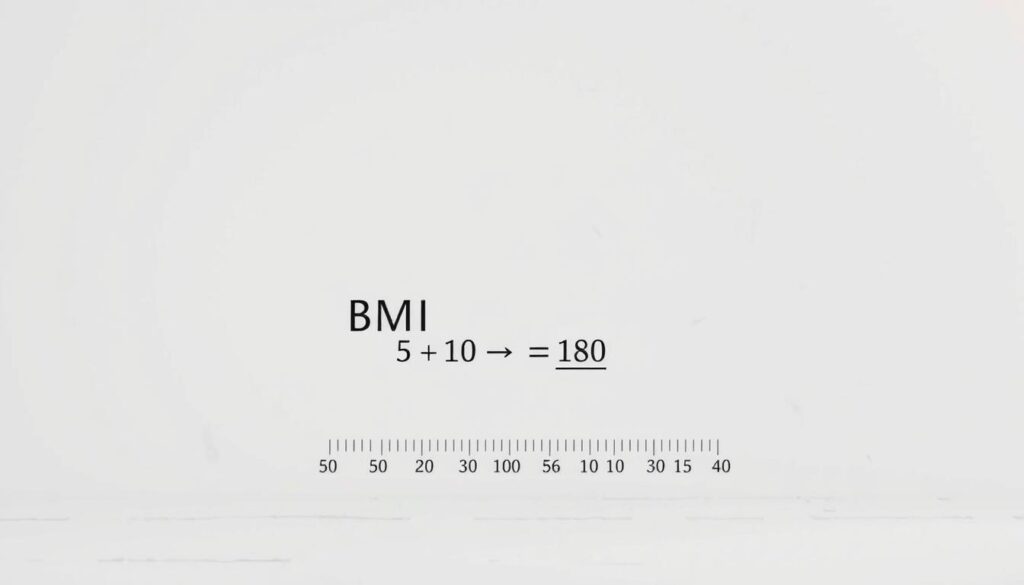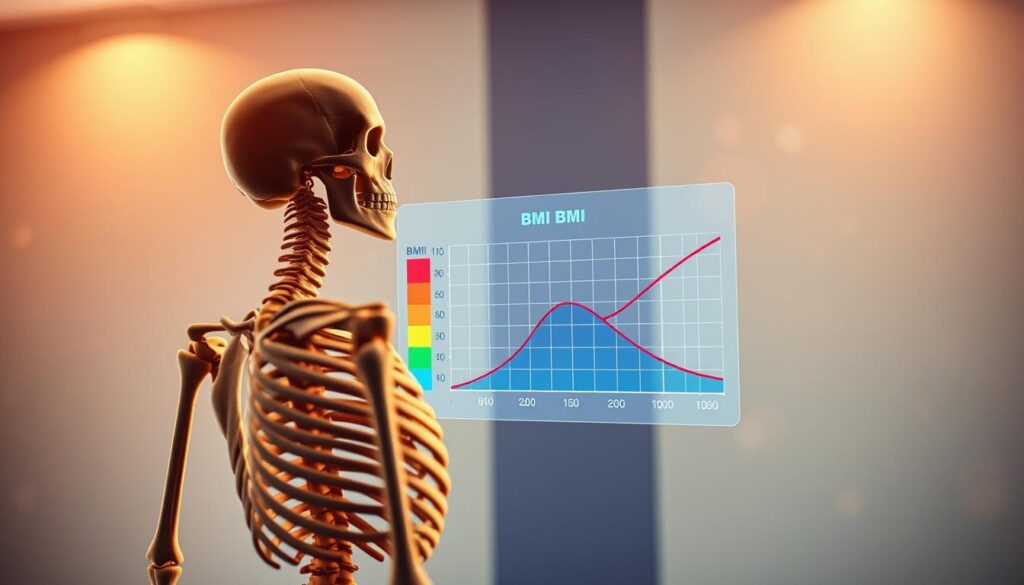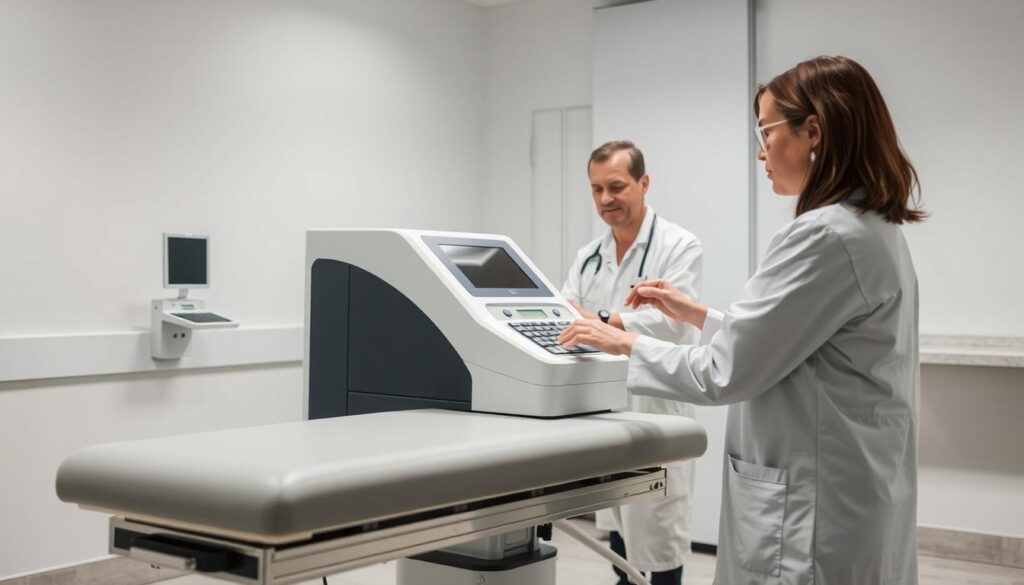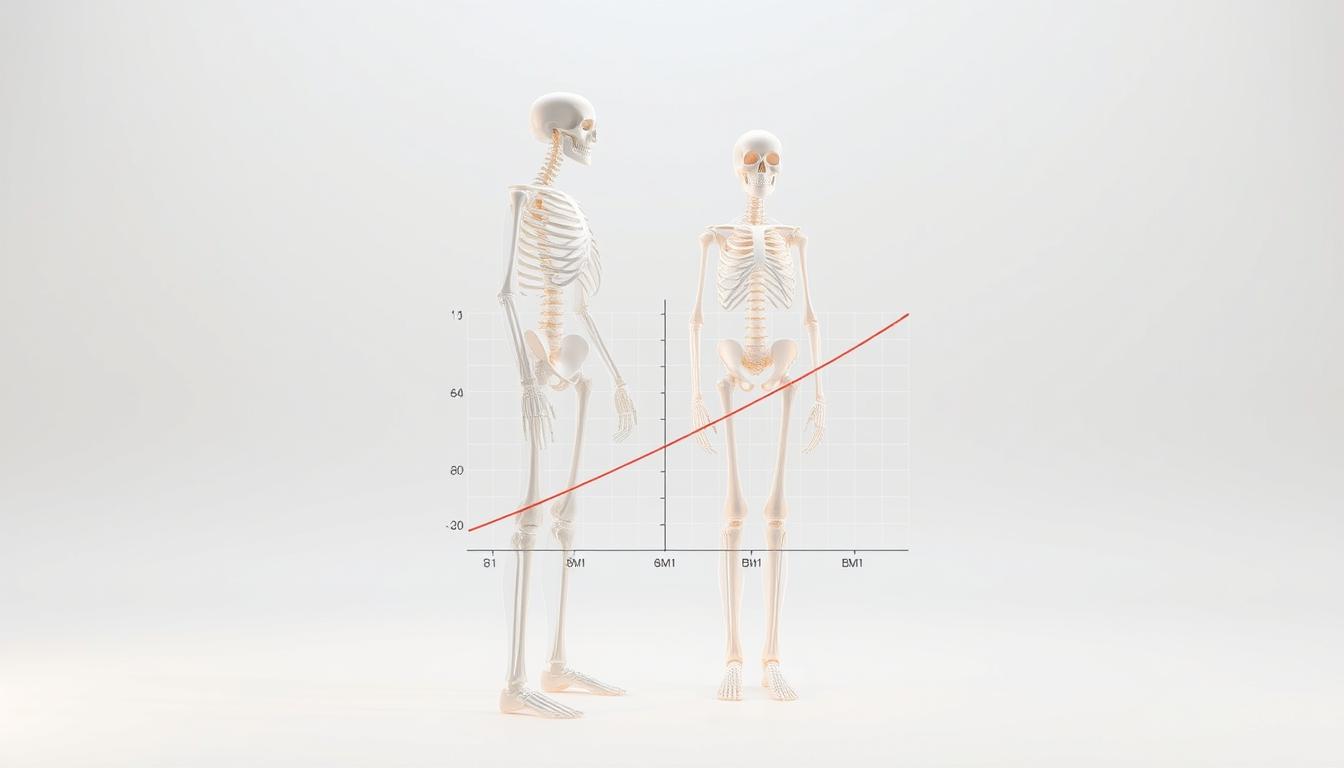Have you ever wondered how your body weight affects the strength of your bones?
Keeping a healthy body mass index is key for your overall health. Research shows it’s also important for bone health. A good BMI can help avoid osteoporosis, which can cause fractures and make moving hard.
We’ll look into how BMI and bone density are connected. We’ll see why keeping a healthy weight is important for strong bones.
Key Takeaways
- Maintaining a healthy BMI is crucial for bone health.
- A healthy body mass index can help prevent conditions like osteoporosis.
- The connection between BMI and bone density is significant for overall health.
- Understanding the importance of BMI and bone density can help individuals take proactive steps towards maintaining strong bones.
- A healthy weight is essential for preventing fractures and mobility issues.
Understanding BMI: Definition and Calculation
To understand BMI, we first need to know what it is and how to calculate it. BMI, or Body Mass Index, is a simple way to check body fat and health risks. It helps identify if you are underweight, overweight, or obese.
What is BMI?
BMI is found by dividing your weight in kilograms by your height in meters squared. This gives a general idea of your weight’s healthiness for your height. For example, a BMI between 18.5 and 24.9 is healthy. A BMI below 18.5 means you’re underweight, and above 24.9 means you’re overweight.
How to Calculate BMI
Calculating BMI is easy. Just use the formula: BMI = weight (in kg) / height (in meters) squared. For instance, if you weigh 70 kg and are 1.75 meters tall, your BMI is 70 / (1.75)^2 = 22.86. 
Many health websites and apps have BMI calculators. They only need your height and weight. Knowing your BMI is the first step to managing your weight and health risks.
Importance of BMI in Health Assessment
BMI is a key tool in health checks because it quickly shows weight-related health issues. A high or low BMI can mean a higher risk of health problems, like diabetes, heart disease, and some cancers. While BMI isn’t perfect (it doesn’t tell lean body mass from fat), it’s a good starting point for health and weight talks.
By knowing and calculating your BMI, you can work towards a healthier weight. This reduces the risk of weight-related health issues. It’s a simple yet effective way to keep an eye on your health and make smart choices for your wellbeing.
The Connection Between BMI and Bone Density
Understanding the link between BMI and bone density is key to assessing health. It helps us know the risk of osteoporosis and fractures. BMI plays a big role in how healthy our bones are.
How BMI Affects Bone Health
BMI categorizes people into weight groups, from underweight to obese. Studies show that BMI is linked to bone density. A higher BMI often means denser bones because it means more body mass, which helps bones grow.
But, the link between BMI and bone density is complex. A high BMI from too much fat doesn’t always mean denser bones. Too much fat can cause inflammation and harm bones.
The Role of Body Fat vs. Lean Mass
The mix of body fat and lean mass affects bone density. Lean mass, like muscle, is key for strong bones. It puts pressure on bones, making them stronger.
Research shows that more lean mass means denser bones, no matter the BMI. But, too much body fat, like visceral fat, is bad for bones.

Evidence from Recent Studies
Recent studies have shed light on BMI and bone density. For example, a study found that higher BMI is linked to denser bones. But, this is mainly because of lean mass, not fat.
To show how BMI affects bone density, let’s look at a table:
| BMI Category | Average Bone Density | Health Implications |
|---|---|---|
| Underweight (<18.5) | Low | Increased risk of osteoporosis and fractures |
| Normal weight (18.5-24.9) | Moderate | Generally healthy bone density |
| Overweight (25-29.9) | Moderate to High | Potential protective effect on bone density |
| Obese (≥30) | High | Generally associated with higher bone density, but potential negative effects of excess fat |
To find out your BMI, use our BMI calculator. It gives you your BMI category right away.
The Importance of Bone Density
Understanding the link between BMI and bone density is key. Bone density is how much minerals like calcium are in your bones. It shows how healthy your bones are.
What is Bone Density?
Bone density shows how strong your bones are. A bone density test, or DEXA scan, measures minerals in your bones. It helps find osteoporosis and fracture risks.
Knowing your bone density results is important. High density means strong bones. Low density means weaker bones that break easily. Your test score compares to a healthy young adult’s.

Why Bone Density Matters for Overall Health
Bone density is crucial for health. It affects your risk of osteoporosis and fractures. Keeping bones strong with diet, exercise, and lifestyle is key.
Understanding bone density results helps you act on your bone health. If your density is low, your doctor might suggest changes or treatments.
The importance of BMI and bone density is huge. They’re linked to your health. A healthy BMI helps your bone density, and vice versa. So, keeping a balanced BMI and good bone density is vital to avoid osteoporosis and fractures.
Factors Influencing Bone Density
Knowing what affects bone density is key to keeping bones strong. Bone density is vital for our health. Many things help keep bones healthy and growing.
Age and Gender Considerations
Age and gender greatly affect bone density. As we get older, our bones naturally weaken. This makes older people more likely to get osteoporosis. Gender also plays a role, with women often having lower bone density than men, mainly after menopause. This is because estrogen levels drop, speeding up bone loss.
A study showed that postmenopausal women face a higher risk of osteoporosis. Early intervention through lifestyle changes and possibly medication can help reduce this risk.
Nutritional Factors Impacting Bone Density
Nutrition is crucial for bone health. Eating enough calcium and vitamin D is key to keeping bones strong. Calcium is a major part of bones, and vitamin D helps our body absorb it. Without enough of these, our bones can weaken.
- Calcium-rich foods include dairy products, leafy greens, and fortified foods.
- Vitamin D can be obtained through sunlight exposure, fatty fish, and supplements.
It’s important to get enough of these nutrients, even more so when we’re young. This is when our bones are building the most.
Physical Activity’s Role in Bone Health
Physical activity is also vital for bone health. Weight-bearing exercises, like walking, running, and resistance training, help bones grow and get denser. Regular exercise not only boosts bone health but also improves physical function and lowers fall risks.
For those with a low BMI, combining good nutrition with exercise is crucial for bone health. On the other hand, staying at a healthy weight through diet and exercise helps keep bones strong.
By understanding and tackling these factors, we can actively work on keeping our bone density healthy for life.
Measuring Bone Density: Techniques and Tools
Healthcare experts use different ways to check bone health. These methods help spot issues like osteoporosis and predict fracture risks.
Dual-Energy X-ray Absorptiometry (DEXA)
Dual-Energy X-ray Absorptiometry (DEXA) is a top choice for bone density checks. It uses X-rays to measure bone mineral density, mainly in hips and spine. DEXA scans are known for their precision, making them a leading choice in bone health testing.
DEXA scans offer detailed insights into bone health. They help doctors diagnose osteoporosis and track treatment success. Yet, they involve some radiation exposure.
Other Methods for Assessing Bone Density
DEXA isn’t the only tool for bone density checks. Quantitative Computed Tomography (QCT) and Peripheral Dual-Energy X-ray Absorptiometry (pDXA) are also used. QCT scans focus on the spine and hip, offering detailed bone health info. pDXA, though, looks at bone density in peripheral bones like the heel or forearm.
Each method has its benefits and drawbacks. For example, QCT scans give detailed bone density and structure info but use more radiation than DEXA. pDXA is more portable and cheaper but might not be as precise for osteoporosis diagnosis.
It’s key to understand bone density test results. Doctors look at T-scores and Z-scores to interpret these tests. T-scores compare a patient’s bone density to a healthy young adult’s. Z-scores compare it to someone of the same age.
By using these methods and understanding their results, doctors can give tailored advice for better bone health.
Maintaining Healthy Bone Density
Keeping your bones healthy is key to staying well. It’s all about eating right and staying active. As we get older, our bones naturally weaken. But, there are ways to keep them strong.
Nutritional Guidelines for Strong Bones
Eating foods rich in calcium and vitamin D is essential. Calcium is vital for bones, and vitamin D helps your body use calcium. You can find calcium in dairy, leafy greens, and fortified foods. Vitamin D comes from sunlight, fatty fish, and supplements.
It’s also good to avoid foods high in sodium and caffeine. They can make it harder for your body to absorb calcium. Make sure you also get enough magnesium and vitamin K for your bones.
Recommended Physical Activities
Doing exercises that make your bones work harder is important. Walking, running, and dancing are great for this. Using weights or resistance bands can also strengthen your bones by putting stress on them.
For better bone density, mix aerobic exercises with resistance training. Don’t forget to add exercises that improve balance and flexibility to lower fall risks.
Ensuring Adequate Vitamin D and Calcium Intake
Vitamin D and calcium are vital for bones. While food is important, supplements can fill in the gaps. Always talk to a doctor to find out how much you need.
Getting regular check-ups for vitamin D and bone density is smart. It helps catch any problems early. This way, you can act fast to keep your bones strong.
| Nutrient | Importance for Bone Health | Food Sources |
|---|---|---|
| Calcium | Critical for bone structure | Dairy products, leafy greens, fortified foods |
| Vitamin D | Aids calcium absorption | Sunlight, fatty fish, supplements |
| Magnesium | Supports bone mineralization | Nuts, seeds, whole grains |
The Impact of High and Low BMI on Bone Health
It’s important to know how BMI affects bone health. Both high and low BMI have different effects on bone density. This is key for staying healthy.
Effects of Overweight and Obesity
People with a high BMI, or being overweight or obese, often have denser bones. This is because their body weight puts more stress on their bones. This stress helps bones grow stronger.
But, it’s important to remember that being overweight comes with health risks. Too much body fat can cause inflammation and other health problems. So, finding a healthy balance is crucial.
Risks Associated with Low BMI
Those with a low BMI face a higher risk of having weaker bones. This is because low bone density can lead to osteoporosis and fractures. A low BMI often means less muscle and fat, which can weaken bones over time.
Also, people with low BMI might not get enough nutrients for strong bones. They might not get enough calcium and vitamin D. Getting enough nutrients is important for keeping bones strong, even more so for those with low BMI.
In summary, both high and low BMI can affect bone health. Knowing this can help us find ways to keep our bones strong and healthy.
Conclusion: Striving for Balance in BMI and Bone Density
Keeping a healthy BMI and bone density is key for good health. It needs a mix of right nutrition, exercise, and managing weight. Knowing how BMI and bone density matter helps people make better health choices.
Key Findings
Studies say a BMI of 18.5 to 24.9 is normal. Staying in this range can lower health risk. Also, research found a link between BMI and bone density, with different ages having different values. For more on this, check out this link.
Achieving Optimal Health
To be at your best, aim for a healthy BMI. Eat well and exercise often. Knowing your bone density can guide your lifestyle choices. For tips on losing weight and checking BMI, see this resource.

